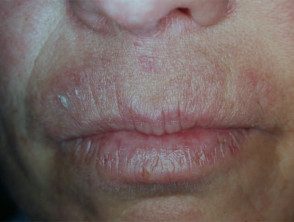What is cheilitis?
Cheilitis is the name given to inflamed lips.
What is allergic contact cheilitis?
Allergic contact cheilitis is allergic contact. dermatitis affecting the lip(s). It is due to a type IV hypersensitivity reaction after contact with a allergen and usually appears as a eczema-I like it inflammation of the external lip or vermilion margin.
Allergic contact cheilitis to hair dye

lip dermatitis
Who gets allergic contact cheilitis and why?
Allergic contact cheilitis is a common cause of inflammation of the lips and is more common than contact. stomatitis, despite considerable overlap in allergen sources. About a quarter of the cases of chronic eczematous Cheilitis is due to allergic contact. The rest is due to constitutional causes and irritating factors
Allergic contact cheilitis is more common in women than in men. It can affect all age groups, but adults are more commonly affected than children. However the Allergens involved vary in different age groups. These differences reflect the usage patterns of different age groups and genders.
- Lip cosmetics are the most common source of allergens in women and toothpastes in men.
- Medications are a major source of allergic contact cheilitis reactions in the elderly.
- Dental materials and oral hygiene products cause cheilitis in all age groups.
- Food reactions mainly affect children.
- Patients often also atopic.
The main sources of allergens that cause contact cheilitis include:
-
Lipsticks and other lip cosmetics, including sunscreens
- Toothpaste and other dental care products (mouthwash, denture cleaner, dental floss, toothpicks)
- Metals: dental restorations, orthodontic devices, musical instruments, metal lip liners, regular suction on metal objects.
- Food
- Medicines
- Nail polish
-
Rubber/latex gloves: rubber dams used during dental treatment, transfer of allergens from worn gloves to hands
Common allergen groups that cause contact cheilitis include:
- metals like nickel
-
Fragrances / Scents
- Preservatives
What are the clinical features of allergic contact cheilitis?
Allergic contact cheilitis usually presents as eczema-like changes on the vermilion margin or the skin around the mouth. One or both lips may be red with dryness, climbing and cracks. The changes can be quite located or affect the entire lip. You can also see the involvement of the corners of the mouth (angular cheilitis). The pattern of the reaction may give some clue as to the cause; for instance allergy to a musical instrument changes will develop only in that part of the lip in contact with the instrument. Allergic contact cheilitis rarely affects the interior mucous membrane lip appearance.
The patient may report associated itching, burning, or pain of the lips.
Pigmented allergic contact cheilitis is a rare variant and presents with pigmentation of the lip that persists after resolution of the eczema.
The clinical examination should include, in addition to the lips, the inside of the mouth and the skin in general. Atopic dermatitis is commonly associated with contact cheilitis.
Which is the differential diagnosis of allergic contact cheilitis?
Contact urticaria of the lip due to a low dose of a frequently used allergen can present as a cheilitis, like a flavoring in a toothpaste. Food is a major cause of contact urticaria of the lips.
Oral allergy syndrome should also be considered in people with allergies to pollen; Onset and recovery are faster than with allergic contact cheilitis.
How is allergic contact cheilitis diagnosed?
Patch The test is the key to the diagnosis of contact cheilitis. The tests must include the base patch test allergen series, as well as cosmetic and toothpaste series, and others suggested by history. It is very important to test the patient's own products and musical instruments as well, if possible. Cosmetics are often applied “as is”, but sawdust from woodworking tools should be applied diluted with 10% in Vaseline. A significant number of patients react only to their own products. The relevance of positive results should be evaluated, based on a careful clinical history and clinical examination. Multiple positive reactions are common.
Repeated Open Application Testing (ROAT) or start-restart testing may be necessary for a patient's own products due to irritation under occlusion in patch tests, as with toothpastes.
Photopatch testing may also be helpful when investigating cheilitis when routine patch testing is negative.
In case of suspected contact urticaria of the lip, a prick/scratch test is required.
It is common for patients with allergic contact dermatitis to have a second diagnosis, such as atopic cheilitis or irritant contact cheilitis.
Treatment of allergic contact cheilitis.
Avoiding the allergen at all its possible sources is the treatment. The reaction usually sets in quickly.

